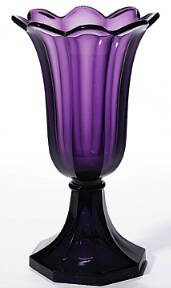Amethyst, a variety of quartz with a vivid purple color, is the birthstone for February. It’s also a highly sought color for decorative glass. Colored glass is made by adding metallic oxides or salts to the raw material. Amethyst glass often gets its color from manganese, which, along with iron, also gives the natural gemstone its color.
Colored glass has been made since ancient times, but, in the United States, it experienced a surge in popularity in the mid-19th century, when lime became a substitute for lead in glassmaking.
This tulip-shaped amethyst glass vase was made between about 1845 and 1865 by the Boston & Sandwich Glass Company, one of the most important American glass manufacturers. It is pressed glass, which emerged in the 1820s with the invention of the pressing machine.
The earliest pressed glass patterns, often called “lacy,” were designed to conceal flaws in the glass. Glassmaking techniques and tools improved by the 1840s, and simpler patterns became popular. Notice how this vase does not have the intricate, heavily textured patterns often associated with pressed glass; it consists of simple shapes and flat panels. The Boston & Sandwich company made it in several other colors as well as clear glass, all of which are desirable. The one shown here sold for $960 at an auction by Jeffrey S. Evans.
Q: I have several classical music albums, etc., and would like to know what they are worth. I have the single record Brahms Violin Concerto, Heifetz, Chicago Symphony and albums Rachmaninoff Concerto 32 in C Minor OP 18. The balance are Time Life Record Albums: Peter Ilyich Tchaikovsky, Wolfgang Amadeus Mozart and Ludwig van Beethoven.
A: Record collecting experienced a resurgence in the 2010s and continues to grow. Many factors affect a record’s price: its format (33 rpm, 45 rpm, 78 rpm, 12-inch, 7-inch, etc.), the label that released it, its release date, condition and album art. Condition is probably the most important. Unless they are buying sealed, never-used records, most collectors buy them to listen to them. They find the sound quality superior to digital recordings. Album art is another factor; if a collector doesn’t intend to listen to the record, they often want to display it as art. Unfortunately, classical records tend to sell for lower prices than rock, blues and jazz. There are specialist websites where you can find more information about your records and check their prices. Try Discogs (www.discogs.com), Goldmine Magazine (www.goldminemag.com), or Money Music (www.moneymusic.com).
Q: I found two Silver Streak irons in my mother-in-law’s estate. Do you or anyone you know have any interest in these irons? I even have the newspaper article from 1985, “Missing Antique: Silver Streak Iron.”
A: The Silver Streak iron, made in the 1940s, is a classic piece of midcentury design. Metal was rationed during World War II, so Corning Glass Works and the Saunders Machine and Tool Corporation created an electric clothes iron made of Pyrex glass. There were versions with a colored emulsion under the glass as well as one that was left clear. Colors included cobalt blue, red and green. The emulsion couldn’t tolerate heat as well as the glass could, so the colors often faded with use. Today, Silver Streak irons are highly desired by collectors of irons and midcentury design. The Museum of Modern Art has one in its Architecture and Design collection. Examples in excellent condition can sell for over $1,000. Even used ones with chipped glass, faded color or missing cords have sold for over $500. If you are planning to sell yours, look into modern design auctions like Rago (www.ragoarts.com), Wright (www.wright20.com/), LA Modern Auction (www.lamodern.com) or Palm Beach Modern Auctions (www.modernauctions.com/).
Comment from a reader: “Your syndicated newspaper column recently answered a question about what to do with WWII memorabilia. Another option would be the D-Day Museum in Conneaut, Ohio, which each year puts on the largest and most historically accurate D-Day reenactment in the country.”
TIP: If a stain in a glass vase or bottle is caused by a chemical deposit, this treatment should remove it: Fill the vase with water, drop in an Alka-Seltzer, and let it soak for about 24 hours. Then, rub the stain with a brush or a cloth.
On the block
Current prices are recorded from antiques shows, flea markets, sales and auctions throughout the United States. Prices vary in different locations because of local economic conditions.
McCoy, vase, figural, tulip, green, 4-footed, marked, circa 1950, 4 by 4 inches, $45.
Textile, pillow, Fornasetti, cream ground, stylized sun faces, printed, cotton, tag, 17½ by 21½ inches, $95.
Box, tantalus, wood, hinged lid, marquetry, center diamond, geometric borders, canted corners, velvet lining, three perfume bottles, square stoppers, gilt, 4 by 6 by 4 inches, $165.
Advertising, case, carrying, Radio Television Service, green, red lettering, top handle & latch closures, hinged sides, holds tubes, 18½ by 13½ by 8 inches, $190.
Furniture, chair, William IV, mahogany, upholstered, green velvet, needlework panel, multicolor flowers and leaves, nailhead trim, turned front legs, open arms, 40½ by 24 by 33 inches, $320.
Toy, wagon, Hy-Speed, red, white lettering, oval bed, fenders, splash guard, pull handle, 1930s, 12 inch-bed, $330.
Delft, spice jar, dome lid, blue and white, flower clusters, double scroll handle, London, circa 1700, 3½ inches, $615.
Carlsbad, compote, dome lid, Vaseline glass, gilt trim, Classical figures, flowers, marked, Moser, 10 inches, $960.
Clock, shelf, Empire style, two-train movement, bronze, patinated, gilt, winged putto pushing wheelbarrow with cask, pendant with winged sphinx supports, oval base, four bun feet, early 1800s, 17½ inches, $1,010.
Sampler, alphabet, multicolor, cross borders, landscape scene, flowering plant in urn, two pine trees, Peggy Bartlett, Massachusetts, frame, 1801, 14½ by 15 inches, $1,355.
Talk to us
> Give us your news tips.
> Send us a letter to the editor.
> More Herald contact information.

























